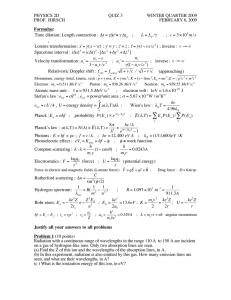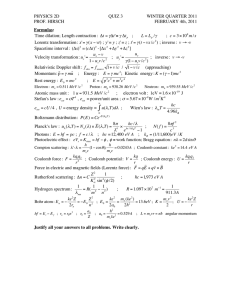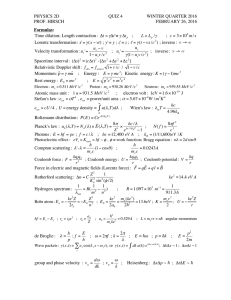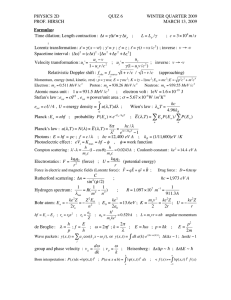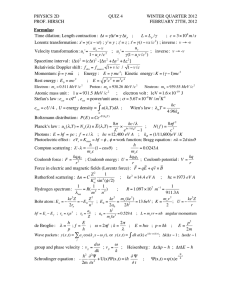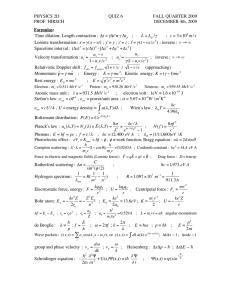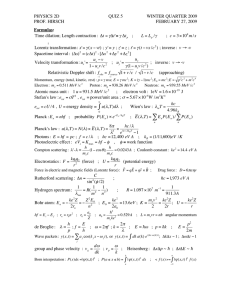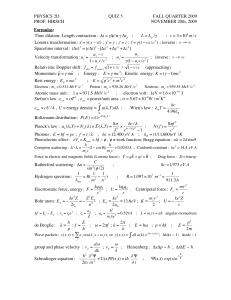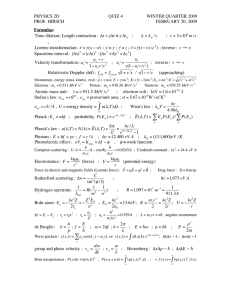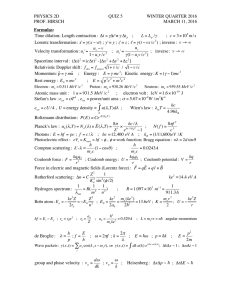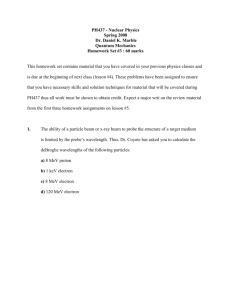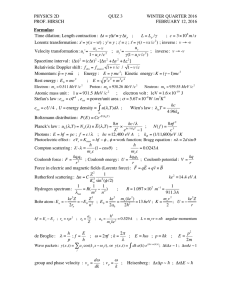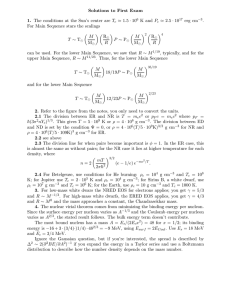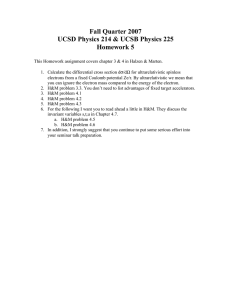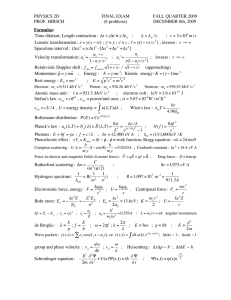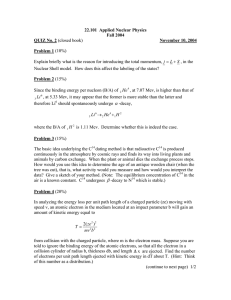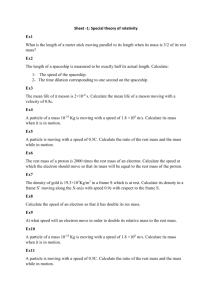PHYSICS 2D QUIZ 4 WINTER QUARTER 2011 PROF. HIRSCH
advertisement
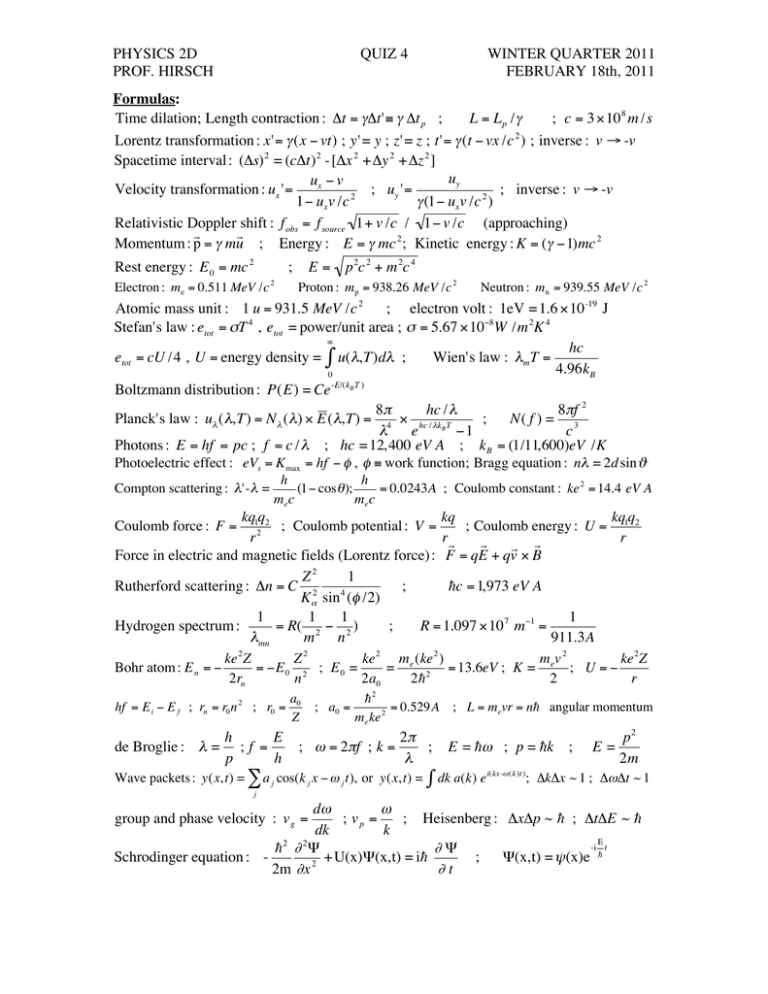
PHYSICS 2D PROF. HIRSCH ! ! ! ! ! ! ! ! ! ! ! ! ! ! ! ! ! ! ! QUIZ 4 Formulas: Time dilation; Length contraction : "t = #"t'$ # "t p ; L = Lp /# ; c = 3 %10 8 m /s Lorentz transformation : x'= " (x # vt) ; y' = y ; z' = z ; t'= " (t # vx /c 2 ) ; inverse : v $ -v Spacetime interval : ("s) 2 = (c"t) 2 - ["x 2 + "y 2 + "z 2 ] uy ux " v Velocity transformation : ux '= ; uy '= ; inverse : v $ -v 2 1" ux v /c # (1" ux v /c 2 ) Relativistic Doppler shift : f obs = f source 1+ v /c / 1" v /c (approaching) r r Momentum : p = " mu ; Energy : E = " mc 2 ; Kinetic energy : K = (" #1)mc 2 Rest energy : E 0 = mc 2 ; Electron : me = 0.511 MeV /c 2 E= p 2c 2 + m 2c 4 Proton : mp = 938.26 MeV /c 2 Neutron : mn = 939.55 MeV /c 2 Atomic mass unit : 1 u = 931.5 MeV /c 2 ; electron volt : 1eV = 1.6 "10 -19 J 4 Stefan's law : etot = "T , etot = power/unit area ; " = 5.67 #10$8 W /m 2K 4 # hc etot = cU /4 , U = energy density = $ u( ",T)d" ; Wien's law : "m T = 4.96kB 0 -E/(kB T ) Boltzmann distribution : P(E) = Ce 8$ hc / " 8$f 2 Planck's law : u" ( ",T) = N " ( ") # E ( ",T) = 4 # hc / "kB T ; N( f ) = 3 " e %1 c Photons : E = hf = pc ; f = c / " ; hc = 12,400 eV A ; k B = (1/11,600)eV /K Photoelectric effect : eVs = K max = hf " # , # $ work function; Bragg equation : n% = 2d sin & Compton scattering : "'- " = h h (1# cos $ ); = 0.0243A ; Coulomb constant : ke 2 = 14.4 eV A mec mec kq1q2 kq kq q ; Coulomb potential : V = ; Coulomb energy : U = 1 2 2 r rr r r r r Force in electric and magnetic fields (Lorentz force) : F = qE + qv " B Z2 1 Rutherford scattering : "n = C 2 ; hc = 1,973 eV A 4 K# sin ($ /2) 1 1 1 1 Hydrogen spectrum : = R( 2 # 2 ) ; R = 1.097 $10 7 m#1 = "mn m n 911.3A 2 2 2 2 ke Z Z ke m (ke ) m v2 ke 2 Z Bohr atom : E n = " = "E 0 2 ; E 0 = = e 2 = 13.6eV ; K = e ; U = " 2rn n 2a0 2h 2 r Coulomb force : F = ! hf = E i " E f ; rn = r0 n 2 ; r0 = ! de Broglie : " = ! WINTER QUARTER 2011 FEBRUARY 18th, 2011 h E ;f = p h a0 Z ; a0 = h2 = 0.529A ; L = me vr = nh angular momentum me ke 2 ; # = 2$f ; k = 2$ ; " Wave packets : y(x,t) = $ a j cos(k j x " # j t), or y(x,t) = E = h# ; p = hk ; % dk a(k) e i(kx -# (k )t ) E= p2 2m ; &k&x ~ 1 ; &#&t ~ 1 j ! ! ! ! d" " ; vp = ; Heisenberg : #x#p ~ h ; #t#E ~ h dk k E -i t h2 " 2# "# h Schrodinger equation : + U(x)#(x,t) = ih ; #(x,t) = $ (x)e 2 2m "x "t group and phase velocity : v g = PHYSICS 2D PROF. HIRSCH QUIZ 4 Time " independent Schrodinger equation : - h 2 # 2$ + U(x)$ (x) = E$ (x) ; 2m #x 2 2 2 ! 2 2 n$x $ hn sin( ) ; En = ; L L 2mL2 Justify all your answers to all problems. Write clearly. " square well : # n (x) = ! WINTER QUARTER 2011 FEBRUARY 18th, 2011 % & dx | $ (x) |2 = 1 -% 2 h = 3.81eVA 2 (electron) 2me Problem 1 (10 points) An electron at time t=0 is described by the wave packet " (x) = C(e i(k1 +k2 )x + e i(k1 #k2 )x ) with k1=1Å, k2=0.1Å, and C a constant. (a) Make a plot of Re(" (x)) (the real part of " (x) ). Indicate in the plot the two x-values ! closest to the origin where " (x) =0. (b) Calling Δx the distance between the two x-values found in (a), give its value in Å. (c) Find the value of Δp for this electron in units eV/c. ! ! (d) Show that the values of Δx and Δp found in (b) and (c) are consistent with the ! uncertainty principle "x"p ~ h . Problem 2 (10 points) A particle is described by the wavefunction ! " (x) = C 4 # x 2 for x in the interval (-2,2) and " (x) = 0 for x outside that interval. ! (a) How much more likely is it to find this particle around x=0 than it is to find it around x=1? Find the ratio of probabilities. (b) Find the value of!the constant C. (c) What is the probability of finding this particle at position x in the range (0,2)? (d) What is the probability of finding this particle at position x in the range (-1,1)? Problem 3 (10 points) An electron is in the ground state of a one-dimensional box. Light with wavelengths in the range 1000Å to 5000Å is incident. (a) Find one possible value for the length of this box (in Å) that will give rise to no absorption line for wavelengths in that range. (There is an infinite number of right answers for this question of course, to get credit you need to justify your answer). (b) Assuming a single absorption line is seen for wavelengths in that range, find the minimum length of this box, in Å. (c) Assuming a single absorption line is seen for wavelengths in that range, find the maximum length of this box, in Å. Hint: use h 2" 2 /2me = 37.6 eV A 2 !
